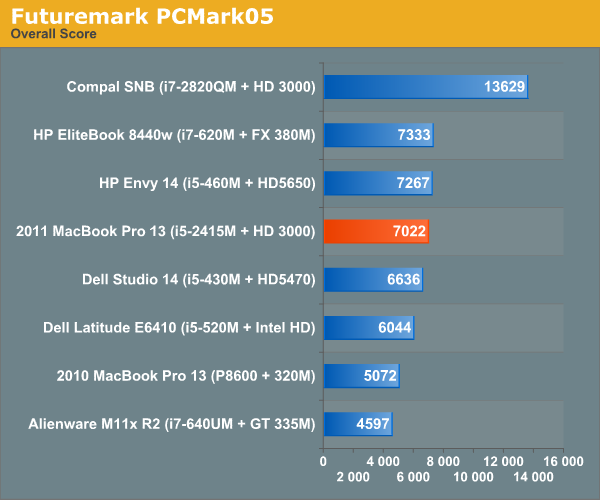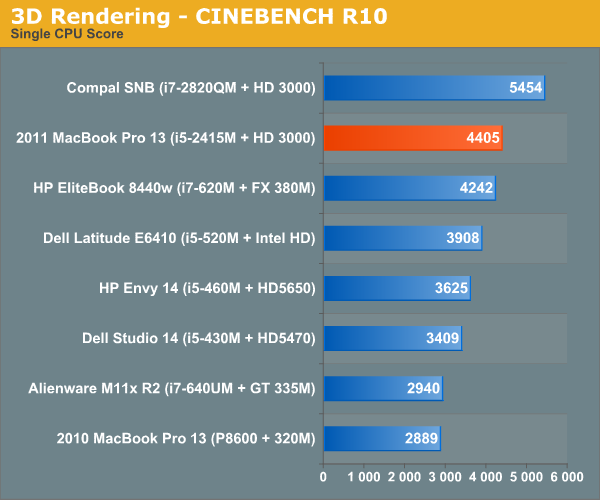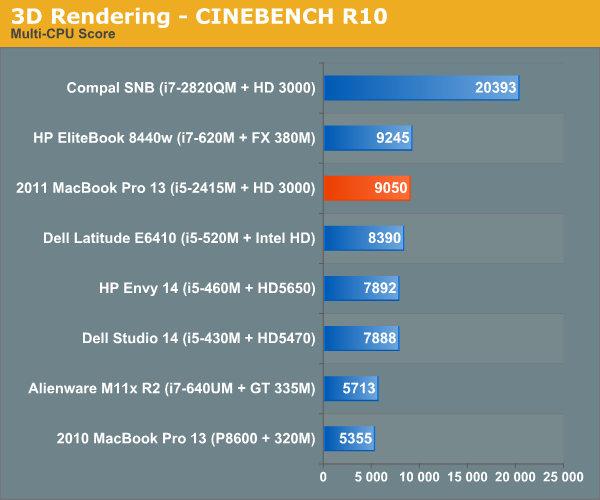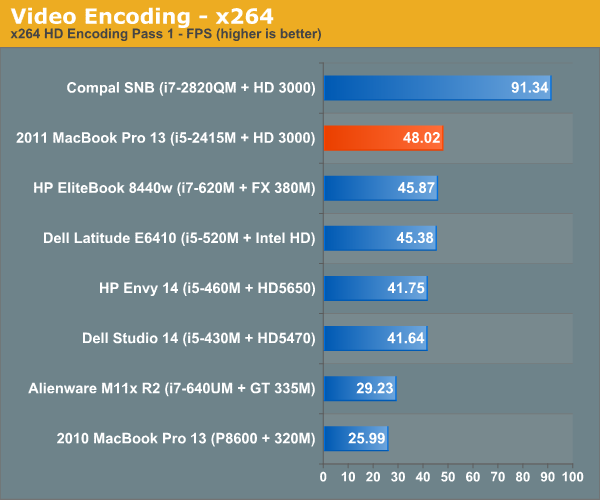The MacBook Pro Review (13 & 15-inch): 2011 Brings Sandy Bridge
by Anand Lal Shimpi, Brian Klug & Vivek Gowri on March 10, 2011 4:17 PM EST- Posted in
- Laptops
- Mac
- Apple
- Intel
- MacBook Pro
- Sandy Bridge
Application Performance in Windows
by Vivek Gowri
In keeping with recent tradition, I'm in charge of evaluating the new MBP under our Windows notebook benchmark suite. Mostly, the MBP works very well as a PC, something I looked at last year with the old 13-inch MacBook Pro. I have the new base 13 in the labs, and I must say, the overall experience is pretty similar...unless you're gaming. But I'll get to that in a minute.
Unlike on the Air I was testing last time around, the Windows install went pretty smoothly thanks to the built-in optical drive. Unfortunately, that's probably going to be the last time I ever use it. And also unlike the Air, there's no problems with storage space here—with the 320GB drive included in the base 13, you have more than enough space for two moderately-sized OS install partitions.
With Windows and Boot Camp drivers out of the way, I fired up our notebook benchmark suite. The new MBP is the first dual core Sandy Bridge notebook we've had in our labs, so I was pretty interested in seeing the performance relative to Arrandale, as well as the old Core 2 Duo-based MBP13. According to CPU-Z, the base spec 13 that I have has the i5-2415M inside, a dual core processor with HyperThreading and clocked at 2.3GHz with max turbo frequency of 2.9GHz. The 2415M is an interesting chip, closely related to the i5-2410M. It's so interesting that Intel doesn't even have a product page for it, which made me curious as to what the difference between the two is. Turns out, the 2415M is the same chip as the 2410M, just in a smaller package. The normal mobile Core i5/i7 processors have a 37.5 x 37.5mm PPGA (plastic pin grid array) package, meant for Socket G2 (also known as rPGA 988B).
The 2415M, on the other hand, has a package size of 31 x 24mm with a micro-FCBGA mounting method. It's the same package size and mounting as the low voltage and ultra-low voltage Sandy Bridge processors, using the same BGA 1023 socket. Apple probably chose the 2415M to make packaging around the processor easier. Smaller is always better in the Apple world.
The other interesting wrinkle here is that Apple has forgone a separate graphics chip for the first time in a very long while. This is the first Apple with Intel graphics since the MacBook's January 2009 refresh brought Nvidia 9400M graphics, and the first MacBook Pro with Intel graphics. Ever.
What does all of this mean for performance? Let's take a look. If you're comparing to the old Core 2 Duo based MBP13, CPU-based performance is almost two times faster across the board. Given the huge jump in power between Core 2 and the further two generations of Core processors, this makes a lot of sense. It was seriously about time that Apple moved on from Core 2 in its smaller notebooks, and this huge performance jump is a direct result. We'll see what happens with the regular MacBook and MacBook Air, but I'd expect a similarly large increase in performance in those models when they're next updated as well.






Looking at the Arrandale-based Core i5-430M, which at 2.26GHz is a logical point of comparison to the i5-2415, we see that performance has improved 15-20%.
This doesn't look as impressive as the gains in performance we saw with our first look at the mobile SNB quad-cores, but Sandy Bridge quads are clocked a lot higher than the preceding Clarksfield chips. Our quad-core SNB mobile testbed had an i7-2820QM, with a 2.3GHz core clock and max turbo frequency of 3.4GHz. The 2820QM replaces the 1.86GHz i7-840QM, so the clock speed is 24% higher. Factor that in, and the increase is more in line with what we saw from the dual-cores.
The big deal here is that now, the lowest end SNB i5 performs roughly on par with the top end Arrandale i7 dual cores. Like Anand said in his Sandy Bridge review, you get yesterday's top of the line performance for a much lower price.










198 Comments
View All Comments
zhill - Friday, March 11, 2011 - link
Good article. I was thinking about your issue with the high cpu utilization, and could it simply be a reporting issue? Could the cpu performance counters or OSX be reporting QuickSync as part of the cpu rather than the GPU? This would certainly be strange and not accurate, but given that intel seems to list QuickSync and HD3000 separately, maybe the reporting stats aren't accurate. Presumably this would be an issue in both Windows and OSX, but at the driver level there could be differences. Just a thought.Have you, or anyone else, noticed heat issues with the MBP lid closed versus open? Aren't the vent ports along the back next to the hinge such that when open they can vent, but when closed airflow could be inhibited?
Anand Lal Shimpi - Friday, March 11, 2011 - link
I thought about that too, but there seems to be a genuine increase in thermal output from the CPU - higher than I'd expect from idle cores and the quick sync engine active.I haven't personally noticed any heat issues with the lid open vs. closed, seems to behave similarly (although now that you mention it I feel like open I do get temperatures a couple of degrees cooler than when it's closed - that could just be psychological though as the comparison is completely unscientific).
Take care,
Anand
Omid.M - Friday, March 11, 2011 - link
Anand,So do the 15-17" MBPs have hardware acceleration support for Flash? I didn't see that explicitly in the review; sorry if I missed it, but I tweeted you asking for this.
The last MBP update, Anand said the 13" he could highly recommend, but the 15" got way too hot under load.
This update, Anand said the 13" he could highly recommend, but the 15" gets way too hot under load.
Hmm. (not insinuating anything, Anand and crew)
I find that odd. But, maybe it's a good thing: I'm not comfortable buying an MBP until Apple build TRIM support for 3rd party SSDs into OSX. I would not want the Apple SSDs.
My early 2008 MBP is still running fine, although I'm tempted by the QC models. Maybe waiting until Ivy Bridge, in hopes of a cooler laptop, will be enough time to see if Apple brings TRIM for after-market SSDs.
I'm disappointed, but I guess this review saved me some money until next year.
Anand Lal Shimpi - Friday, March 11, 2011 - link
Sorry I think I missed your tweet! I measured around 40 - 60% CPU utilization of a single core when viewing a 1080p HD video in YouTube on the new 15-inch MBP (same CPU usage for both the iGPU and dGPU).The frame rate was perfectly smooth, but it's unclear to me how much lifting is being done by the GPU here.
Last year's 15 was pretty warm, but this year's model definitely didn't take a step back in that department - transistor count nearly doubled after all!
The move to 22nm should bring about marginal updates to architecture so I'm hoping for lower power consumption at similar performance levels.
Take care,
Anand
Omid.M - Friday, March 11, 2011 - link
Anand,You mentioned in the last MBP refresh/review that the 13" showed support for TRIM in OSX (evidenced in System Profiler, I believe).
You also said in this refresh/review that Apple supports TRIM for its own SSDs only.
To my knowledge, the last MBP generation had the SSD option for both 13" and 15-17" models, meaning the same SSD was offered across all models.
If TRIM is only supported for Apple SSDs, why did we see an evidence of TRIM in last year's 13" model but no evidence for the 15/17, assuming the same SSD was offered across the entire line and assuming the version of OSX shipped with the last models was the same across the line?
Was that due to different chipset drivers because the 13" had the Core 2 Duo/Nvidia combo, and the older 15/17 had Core i5/i7 (thus, newer chipset) ?
Does it make sense what I'm asking?
tno - Friday, March 11, 2011 - link
Apple ships different versions (small tweaks) of OSX with different laptops, and there is the key. If you recall, the field in System Profiler was populated indicating that at some level the chipset (Nvidia sourced) supported the instruction, but SSDs that supported the instruction did not.So you're correct, Nvidia chipset driver supported TRIM, but the OS did not implement the instruction. The Core i5/i7 integrated chipset driver had no support for TRIM.
http://www.anandtech.com/show/3762/apples-13inch-m...
name99 - Friday, March 11, 2011 - link
"I saw a number of different MCS (modulation coding scheme) values with the 2011 MBP in the exact same place. Link rates from just below 300 Mbps all the way up to the expected 450. It seems to settle out at the expected 450 Mbps in the same room as the AP, it just takes a while, whereas other 2x2 stacks I've seen always lock onto 300 Mbps and stay there in the same room and position."Is the state of the art any better than this?
The reason I ask is that the simple WiFi problem (1x1 antenna, what is the best modulation + puncturing I should use for this SINR?) is well understood.
But once MIMO enters the picture there are so many more options available --- for example: should we try to use all receive antennas for different streams, and run those three streams at "robust" modulation, or should we transmit a single "fragile" (64-QAM, 5/6) stream, and rely on receive diversity to be able to detect it without error? If we send a "fragile" stream, should we use the transmit antennas to perform beam shaping to target more power at the target?
As I understand it, optimal methods for handling the juggling between all the different types of diversity available in the MIMO space still do not really exist (if anyone has a reference stating otherwise, please provide it).
If this is the case, it would not surprise if, on either the base station end, the laptop end, or both, you have a huge amount of bouncing around between different possibilities (of course with 3x3:3 the space is larger than with 2x2:2 or 2x3:2) because what is being used to make the choices are simply heuristics, not engineered algorithms, and the heuristics are extremely sensitive to the slightest changes in the SINR covariance matrix).
Brian Klug - Friday, March 11, 2011 - link
I haven't really played around enough with other 3x3 WiFi stacks enough to say for certain. I agree with you that a lot of this is it making some decisions based on whether to prioritize connection robustness or throughput rate. At close ranges, it certainly selects MCS that gives most throughput, but I'm still shocked to not see more 450 Mbps when in the exact same room as the AP.Moving away, you'll quickly fall back to single stream rates (but obviously still get MIMO range extension). You're exactly right that everyone has their own heuristics for how to do this based on SINR. I still haven't figured out how to actually grab SINR out on here, all I can see for the moment is just RSSI. Completely agreed though.
-Brian
MrCromulent - Friday, March 11, 2011 - link
Once again a very detailed, comprehensive and yet easy to understand article!I'd like to inquire once more about the C300: In the initial test, the C300 was criticized for poor garbage collection. Now it's considered an option for Apple notebooks. Has the GC been improved by Marvell in the last few firmware updates?
Griswold - Friday, March 11, 2011 - link
Interesting revenue information right at the start. Apple went from a computer- to a music&player- to a phone company. :P